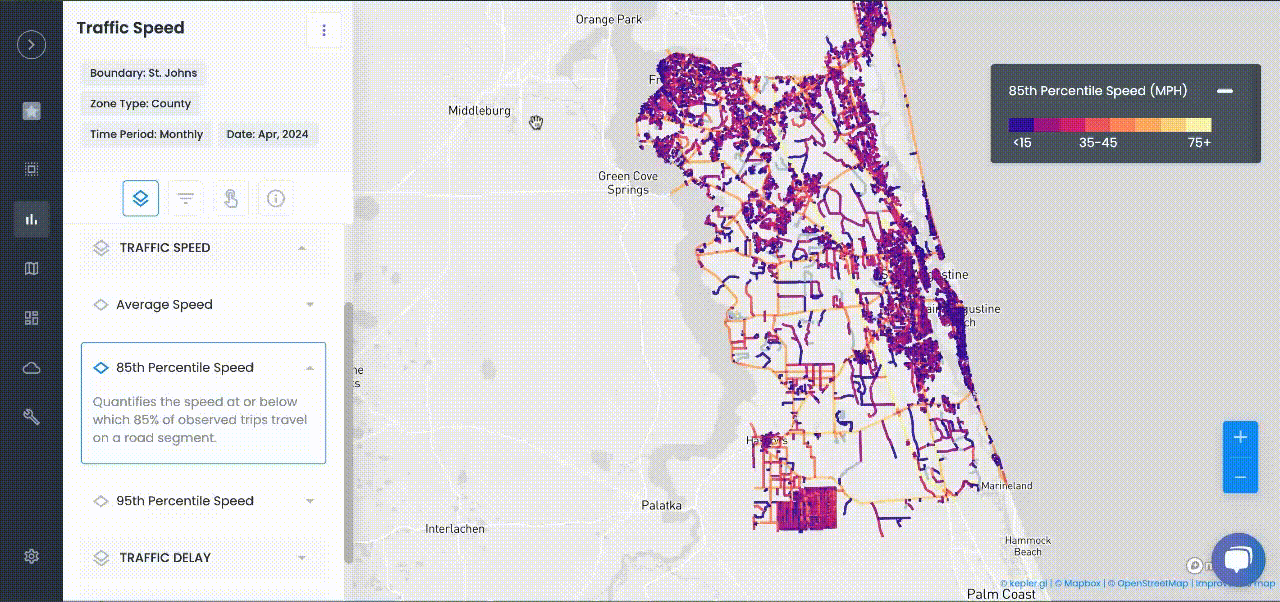
Road Safety
Geospatial AI for School Zones: Smarter Traffic Calming with Urban SDK
Geospatial AI helps cities forecast and prevent traffic incidents near schools.
Discover how Urban SDK’s Geospatial AI helps cities forecast and prevent traffic incidents near schools. Real-time data, AI-driven insights, and safer streets for students.
As cities expand and traffic volumes rise, keeping children safe around schools is becoming increasingly complex. Narrow sidewalks, distracted drivers, and unpredictable congestion all create hazardous conditions during school drop-off and pick-up hours.
And the data paints a troubling picture. According to the National Highway Traffic Safety Administration (NHTSA), 1 in 5 children under 15 killed in traffic crashes were pedestrians—many of them near schools. In some cases, vehicles are speeding through school zones by as much as 10 to 15 mph over the limit, according to studies by the National Center for Safe Routes to School.
Traditional traffic calming solutions—like speed bumps, signage, or crossing guards—serve an important role. But they’re often reactive, static, and unable to adapt to real-time risks.
That’s why cities and agencies are now turning to Geospatial AI. By analyzing real-time traffic patterns, identifying danger zones, and delivering proactive insights, Urban SDK’s Geospatial AI platform offers a smarter, safer way to manage traffic around schools. It’s not just about slowing cars—it’s about anticipating risks and preventing incidents before they happen.
This blog explores how Geospatial AI is modernizing school zone safety—from the technology behind it to the practical ways it’s being deployed in communities today.

Understanding Geospatial AI
Geospatial Artificial Intelligence (AI) integrates location-based data with advanced analytics, machine learning, and automation. It allows agencies to detect patterns in traffic behavior, and deploy targeted interventions.
Where traditional traffic calming is reactive—installed after repeated complaints or crashes—Geospatial AI enables data-led, real-time decision-making. By leveraging:
- Historical crash data
- Connected vehicle data
- Speed and congestion trends
- Environmental conditions
Geospatial AI can flag risks before incidents occur. This predictive capability is essential for school zones, where small moments of distraction can lead to serious outcomes.
The Role of Geospatial AI in Traffic Calming
Traffic calming strategies like raised crosswalks and narrowed lanes are staples of school zone design. However, their effectiveness depends on consistent enforcement and community awareness.
With Geospatial AI, cities can go further — and more proactively. Urban SDK’s AI Traffic Calming Solutions enable agencies to:
- Pinpoint speeding trends by time of day or day of the week
- Identify zones with near-miss events, not just reported crashes
- Integrate with enforcement tools to trigger alerts or dispatch officers
- Adjust variable messaging signs based on real-time congestion or pedestrian activity
The FHWA’s Safe Routes to School program recommends using “data collection and technology tools to target the most dangerous areas for children walking or biking.” Geospatial AI fulfills that recommendation—at scale.
Benefits of Implementing Geospatial AI for School Safety
1. Proactive Risk Detection
AI models trained on local conditions can identify high-risk periods, such as rainy Monday mornings or late Friday pickups. This allows for temporary, targeted interventions like flashing beacons or mobile signage only when needed.
According to the U.S. DOT, a 10-minute improvement in emergency response time can reduce crash fatality rates by up to 44%. Quick response begins with better awareness—and Geospatial AI supports both.
2. Real-Time Monitoring & Alerts
IoT devices like radar sensors or vision-based AI cameras can flag dangerous behaviors—speeding, illegal turns, or stop sign roll-throughs—as they happen. Urban SDK helps agencies centralize this data to take quick action.
3. Cost-Efficient Urban Planning
Not all schools face the same risks. With Geospatial AI, cities can prioritize low-income or underserved areas that often lack pedestrian infrastructure—aligning with federal equity goals under SS4A (Safe Streets for All).
4. Community Transparency and Buy-In
Geospatial dashboards make it easier to present data to school boards, PTAs, and city councils. When parents can see exactly where dangers lie, public support for interventions grows stronger.
5. Evidence-Based Policy Development
Agencies can support grant applications, justify funding, and meet federal guidelines by showing quantifiable risk reduction, not just anecdotes. This aligns with FHWA’s performance-based approach to school safety funding.
Key Technologies Behind Geospatial AI
To deliver these insights, several technologies work together:
- AI-Enhanced Traffic Cameras: Detect speeding, failure to yield, and other infractions.
- Vehicle & Pedestrian Tracking Sensors: Understand real-time movements and crowding.
- Machine Learning Algorithms: Continuously improve predictions based on new data.
- Digital Twins: Create virtual models of school zones to test “what if” scenarios before making physical changes.
- GIS Mapping Tools: Allow city planners to visualize school risk zones interactively.
The National Digital Twins program by NIST promotes using digital replicas for safer, more efficient infrastructure. Urban SDK's platform is aligned with this future-ready standard.
Integrating with Existing Systems
Geospatial AI isn’t a rip-and-replace solution. Urban SDK is designed to plug into existing infrastructure and amplify what agencies already use:
- Traffic Signal Systems: AI helps adjust timing to calm traffic during school hours.
- School Notification Tools: Integrate alerts into parent and staff communications.
- Public Safety Dispatch: Coordinate enforcement patrols in high-risk zones automatically.
- Digital Signage: Update messages dynamically, such as “Slow Down: Students Present.”
Even agencies starting with limited resources can adopt a phased approach—beginning with a pilot around one or two schools, then scaling as they gather data and buy-in.
Where Geospatial AI is Headed Next
The future of school safety will be shaped by:
- Edge AI Cameras with onboard processing, reducing need for centralized review
- AI Drones to monitor traffic conditions from above
- Mobile App Integrations to notify parents and students when crossings are unsafe
- Automated Violation Reports that streamline enforcement and reduce manual workloads
- Equity Audits, ensuring that underserved schools get the same level of safety as wealthier neighborhoods
And with federal funding available through programs like Vision Zero, SS4A, and Reconnecting Communities, cities have more tools than ever to act.
Keeping Students Safe with Smarter Tools
Keeping students safe on their daily routes to school requires more than speed signs and painted crosswalks—it requires a comprehensive road safety strategy supported by real-time traffic safety data. It demands real-time data, roadway insights, and smart collaboration between city agencies, schools, and communities.
Urban SDK’s Geospatial AI platform is purpose-built to deliver exactly that—helping transportation departments:
- Identify and mitigate high-risk school zones
- Engage residents through transparent data
- Support smarter, faster safety interventions
As school zone challenges grow more complex, cities need technology that keeps pace. The tools are ready—and so is the opportunity to act.
Because protecting our students isn’t just good policy. It’s the future of smart, safe cities.

TRAFFIC ENFORCEMENT FEATURES
80% of citizen complaints
are a perception problem
Urban SDK provides precise hourly speed data to evaluate complaints and deploy resources efficiently for the greatest impact to public safety.
Urban SDK provides precise hourly speed data to evaluate complaints and deploy resources efficiently for the greatest impact to public safety.
Target Speeding
Identify hot spots, validate monthly speeding trends and monitor vulnerable areas like school zones.
Improve Safety
Crash and citations location information to compare speed trends month over month
Fast Response
Respond to citizen complaints sooner with address search and exportable reporting
Deploy Assets
Generate maps for traffic enforcement by time of day, location or division to deploy officers to known problem areas.
RESOURCES
Customer Success
See how public sector leaders succeed with Urban SDK.
WEBINAR
Identify speeding and proactively enforce issues
See just how quick and easy it is to identify speeding, address complaints, and deploy officers.







